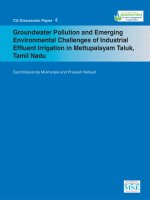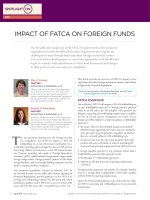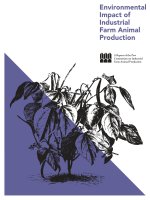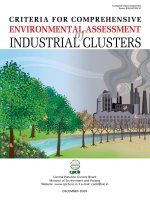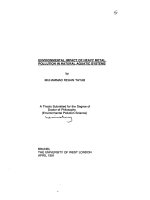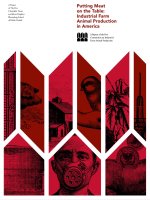Environmental Impact of Industrial Farm Animal Production ppt
Bạn đang xem bản rút gọn của tài liệu. Xem và tải ngay bản đầy đủ của tài liệu tại đây (5.31 MB, 56 trang )
A Report of the Pew
Commission on Industrial
Farm Animal Production
The Pew Commission on Industrial Farm Animal Production was
established by a grant from The Pew Charitable Trusts to the Johns
Hopkins Bloomberg School of Public Health. The two-year charge to the
Commission was to study the public health, environmental, animal welfare,
and rural community problems created by concentrated animal feeding
operations and to recommend solutions.
Like many industries, Industrial Farm Animal Production (ifap)
results in a number of environmental impacts that affect populations
both near and far. While every industry may contribute to society via
production of some necessary or desired good, as our population increases,
we have become more and more aware of the finite nature of our world’s
resources and of the impacts of our various industries upon those resources
and our own human health. Industrial farm operations impact all major
environmental media, including water, soil, and air. Of most concern are the
pollution of ground and surface water resources with nutrients, industrial and
agricultural chemicals, and microorganisms; the use of freshwater resources;
the contamination and degradation of soil; and the release of toxic gases
and odorous substances, as well as particulates and bioaerosols containing
microorganisms and pathogens. The Commission queried the authors of
this report on the magnitude and key determinants of these impacts, and the
resulting impacts on both human health and ecosystems.
The major causes of the above noted environmental impacts of ifap
are the enormous amounts of waste that are produced in a very small area
in this agricultural model, the inadequate systems we now have to deal with
that waste, and the large energy and resource inputs required for this type of
production, including feed production and transport.
The usda Agricultural Research Services (ars) estimated the manure
output from farm animals in the United States to be nearly 1 million US
short tons of dry matter per day in 2001. Eighty-six percent of this was
estimated to be produced by animals held in confinement. Different groups
have posited both lower and higher estimates, but the fact remains that food
animals produce an enormous amount of waste every day, exceeding human
sanitary waste production by at least one order of magnitude. However,
disposal of this waste is far less closely regulated than disposal of human
waste. Animal manure and other agricultural waste result in water and
air degradation, which in turn impact both the aquatic and the terrestrial
ecosystems surrounding these operations.
In addition to the enormous waste produced by industrial agriculture,
this system requires major inputs of both energy and resources. Water use
is more significant in these systems because it is often used for cleaning the
buildings and in the waste management systems. In addition, the industrial
model utilizes feed, which is grown in monocultures, often far away from the
facility. Enormous quantities of both water and petroleum-based pesticides
may be used in the production of this feed, leading not only to the depletion
of water resources, but also to soil erosion and pollution with pesticides.
Pesticide residues may remain in the animal feed, leading to the possibility of
toxic residues in the food animals themselves. Feed crop monocultures also
contribute to loss of biodiversity, as they are planted in place of other plants
and /or animal habitats.
Finally, but growing more urgent every day, industrial agriculture may be
a significant contributor to climate change, as the production of greenhouse
gases from these facilities (both from the animals themselves and from the
decomposition of their waste) is significant.
Taken together, these data suggest that the present industrial model of
farm animal production is not sustainable for the long term. The overuse and
degradation of natural resources may be too great to allow the current form
of this production model to continue to be viable. The commission requested
that the authors of this report investigate the scope of these environmental
factors, to help grasp the breadth of the possible impacts of the ifap system.
By releasing this technical report, the Commission acknowledges that
the author /authors fulfilled the request of the Commission on the topics
reviewed. This report does not reflect the position of the Commission on
these, or any other, issues. The final report, and the recommendations
included in it, represents the consensus position of the Commission.
An array of adverse human health effects have begun to
be documented in conjunction with the rise of industrial
farm animal production (ifap) (Sapkota et al., 2007b;
Donham et al., 2007). Health outcomes observed in
farm workers and exposed rural populations include an
increased prevalence in serious respiratory diseases (up
to 25% for workers in the swine industry) (Heederick
et al., 2007), bacterial infections that may be resistant
to antimicrobials, and a general decline in physical,
mental, and social wellbeing, as perceived by affected
rural populations (Donham et al., 2007; Gilchrist et al.,
2007; Heederick et al., 2007).
This paper explores the magnitude and key
determinants of ifap impacts on air, water, and soil, and
the resulting impacts on human health and ecosystems.
To gain a proper understanding of the origin of
environmental and human health issues surrounding
modern animal farming, it is important to define
current agricultural farming practices and contrast them
with traditional methods that evolved over the course of
centuries in the interplay between farmers, their land,
and the animals raised.
In the past few decades, American farming has
undergone significant changes. Today, 54% of US food
animals are concentrated on only 5% of the remaining
farms. ifap is designed to increase production yield
and decrease production costs by using high-efficiency
practices that rely heavily on economies of scale as well
as on a standardization of processes and end products
(Sapkota et al., 2007b). This model differs from
traditional farming in both approach and scale. The
traditionally numerous but small and independently
owned and operated farms have largely been replaced
with a much more limited number of large facilities for
growing food animals. These large farming operations
now supply most of the meat and poultry products
for domestic consumption and for markets around
the world. ifap employs high-throughput farming
of thousands of animals of a single breed for a single
purpose, such as the large-scale production of hogs,
broiler chickens, turkeys, or dairy cattle, often in
confined locations under highly controlled conditions
using formulated foods in lieu of access to forage.
These facilities are known as animal feeding operations
(afos). According to the US Environmental Protection
Industrial farm operations adversely impact all major environmental media,
including water, soil, and air. Key issues of concern for ecological and human
health include the contamination of ground and surface water resources with
nutrients, industrial and agricultural chemicals, and microorganisms such
as viruses, bacteria, and parasites. Unsustainable use of freshwater for feed
production, animal care, and slaughterhouses contributes to water scarcity
and is depleting precious resources needed by future generations (Burkholder
et al., 2007; Walker et al., 2005). Contamination of soil is another pervasive
problem caused by the unsustainable, year-round deposition of excess
nutrients, chemicals, and pathogens on land in the vicinity of industrial
feeding operations. Poor air quality results from the localized release of
significant quantities of toxic gases and odorous substances, as well as
particulates and bioaerosols containing a variety of microorganisms and
human pathogens. Adverse ecological outcomes include excessive nutrient
loading and euthrophication of surface waters resulting in oxygen-depleted
dead zones in both inland and marine surface waters, recurring algal blooms,
fish kills, and a decline in species populations and biodiversity.
Agency (epa), an animal feeding operation (a fo) is a
lot or facility (other than an aquatic animal production
facility) where the following conditions are met: (a)
animals have been, are, or will be stabled or confined
and fed or maintained for a total of 45 days or more in
any 12-month period; and (b) crops, vegetation, forage
growth, or post-harvest residues are not sustained in the
normal growing season over any portion of the lot or
facility (US epa Compliance Assistance website).
Concentrated animal feeding operations (cafos)
are a sub-category, which previously was defined based
on animal units, but now instead is determined by the
actual number of animals at the operation. cafos can
be divided into small, medium, and large operations
based on the number of animals housed, as specified on
the US epa Compliance Assistance website. Presently,
cows, hogs, and poultry, i.e., turkeys and chickens, are
the most common food animals raised in cafos in the
United States.
Industrialized farm animal production evolved
from a change to a management structure, in which
a corporation controls all aspects of production
from the selective breeding of young animals to the
processing of animal meat into consumer products.
This organizational structure is referred to as vertical
integration (Economic Research Service /usda,
undated). A distinctive feature is that most or all
management and economic responsibilities of animal
production lie with companies known as integrators.
The shift from traditional animal husbandry
to ifap has occurred rapidly in the United States,
mostly within the last five decades. It has transformed
the structure of rural communities and impacted
environmental quality and public health in its wake.
Today, fewer people are raising more food animals,
and the traditional model of the self-employed farmer
has shifted to that of a grower of animals, responsible
only for raising young animals to market weight using
methods prescribed by entities external to the geographic
location of the animal production site (usda /nass,
2005). While growers may still own the land and
structures used for farming, they no longer own the
animals and do not grow animal feed crops. This loss
of independence is offset by the perceived benefits to
farmers of obtaining price stability and a multi-year
contract (usda /ers, undated). In ifap, growers
typically perform contract work for the integrators,
who provide young animals and the formulated feed.
They also control the terms and conditions of animal
production and set the compensation paid to the grower.
Whereas it is the grower’s responsibility to carry out
day-to-day operations, the integrators are instrumental
in determining and administering veterinary care and
inspection, as well as in managing animal removal
from the grower’s site, mostly by using contract labor.
Animals having reached market weight are then
taken to integrator-owned and -managed plants that,
increasingly, furnish ready-to-sell consumer products for
the retail market (Figure 1).
The shift in animal production toward this
industrialized business model has important
environmental and public health implications. Today,
more animal waste than ever before is produced by a
very limited number of large farms. The disposal of
these unprecedented amounts of animal waste generated
in a few discrete locations poses new and significant
challenges. Animal waste or manure, which traditionally
has been regarded as a welcome source of nutrients for
soil improvement (often referred to as amendment), in
many cases, has turned into a liability and a problematic
byproduct causing ecosystem degradation and public
health concerns in communities surrounding ifap
facilities (Osterberg and Wallinga, 2004). High-density
confinement of animals has created indoor air pollution
hazards for workers and significant point sources
for outdoor air pollution (Mitloehner and Schenker,
2007). Industrial animal farming practices also have
promoted the use of non-traditional chemicals in
agriculture, including antimicrobials for disease control,
prophylaxis, and growth promotion, as well as heavy
metal–containing arsenicals for control of parasitic
diseases (Graham et al., 2007). The presence of these
non-traditional chemicals in animal waste poses new
challenges for appropriate management. Furthermore,
the centralization of animal production facilities
has made American agriculture more vulnerable to
large-scale outbreaks of food- and waterborne diseases,
thereby adversely impacting food safety and food
security (Gilchrist et al., 2007). Finally, centralized
meat production and animal slaughtering houses have
increased energy consumption, long-distance transport
of agricultural products, and the output of noxious gases
suspected of contributing to air quality degradation,
adverse human health effects, and climate change
phenomena (Heederik et al., 2007).
In the United States, an estimated 173,000 miles of national waterways
are impacted by runoff from agricultural sources (Cook, 1998). Animal
farming is estimated to account for 55% of soil and sediment erosion, 37%
of nationwide pesticide usage, 80% of antibiotic usage, and more than 30%
of the total nitrogen and phosphorus loading to national drinking water
resources (Steinfeld et al., 2006).
There are three root causes of environmental degradation from ifap:
1 The large volumes of animal waste produced;
2 Lack of appropriate management and disposal of these materials; and
3 Unsustainable water usage and soil degradation associated with feed
production.
Before these environmental issues are explored in greater
detail, it is important to gain an appreciation for the
scale of ifap operations in the United States and how
extensively they have penetrated the national agricultural
sector.
Contract production of meat in ifap facilities is a
national phenomenon now dominating the agricultural
sector. In 1999, the ifap business model already
accounted for almost the entire broiler production, more
than 60% of the hog production and about 35% of the
cattle output (Donham et al., 2007; US Government
Accountability Office, 2005). Today, eight years later,
its role certainly is even more pronounced. (Release of
updated information by the usda is pending.)
The trend toward intensive, industrialized
production of confined cattle, hogs, and poultry can be
illustrated by the broiler industry. Figure 2 shows the
relative increase of very large ifap facilities producing
tens of thousands of broilers per year.
Over the course of several decades, millions of
US backyard operations featuring small flocks of
chickens often raised for the dual purpose of egg and
meat production have been replaced with less than 50
agricultural firms that operate as highly specialized,
vertically integrated businesses with most of the
production coming from the top four integrators (usda-
nass undated [http: / /www.usda.gov /nass /pubs /
trends /broiler.htm]; usda-ers undated).
Hallmarks of new production techniques are high-
density facilities in which 25,000 to 50,000 confined
chickens are raised to market weight within a few
weeks by automated feeding apparatuses dispensing
a growth-optimized diet usually supplemented with
antimicrobials that also are used as life-saving remedies
in human medicine. Use of these techniques has allowed
for a doubling of broiler production from 1980 to 1999
(usda-nass undated [http: / /www.usda.gov /nass /
pubs /trends /livestockproduction.csv]) and has triggered
a remarkable reduction in prices of broilers, now
available for less than what was charged (in inflation-
adjusted dollars) in the 1950s (usda-ers undated).
However, this seemingly favorable cost comparison
of meat from ifap versus traditional farms does not
account for environmental and public health costs.
Statistics for the hog industry show similar trends
of a sharp decrease in the number of farms and a
notable increase in their sizes. In 2005, the United
States produced more than 103 million pigs at 67,000
production facilities (usda 2006a; 2006b). Facilities
housing tens of thousands of pigs accounted for more
than half of the total US swine inventory, reflecting the
increasing consolidation and concentration of US swine
production (usda 2006a).
Statistics for the US broiler and pork industry
show today’s animal production to be dominated by
ifap practices (Figure 3). This trend has resulted in
the generation of large volumes of wastes in relatively
confined geographical areas. For example, swine manure
is typically stored in deep pits or outdoor lagoons and
then applied to agricultural fields as a natural fertilizer.
However, runoff events and percolation (i.e., water
soaking into the ground) of manure components,
including bacteria pathogenic to humans as well as
chemical contaminants, have impacted surface water
and groundwater proximal to swine cafos, thereby
posing health risks to the environment and human
populations (Anderson and Sobsey, 2006; Campagnolo
et al., 2002; Jongbloed and Lenis, 1998; Krapac et al.,
2002; Sayah et al., 2005; Thurston-Enriquez et al.,
2005; Sapkota et al., 2007a).
By any estimate, the total amount of farm animal waste
produced annually in the United States is substantial.
In its report for the year 2001, the usda estimated the
output of manure from farm animals at 920,000 US
short tons of dry matter per day (usda ars 2002). This
translates to greater than 300 million metric tons of
dry mass or more than 660 billion pounds per year. Of
this mass, 86% (788,000 tons per day) was projected to
stem from animals held in confinement. In contrast, the
American Society of Agricultural Engineers provides a
higher estimate of 540 million metric tons of dry weight
excreta per annum (American Society of Agricultural
Engineers, 2005). Lower estimates of 133 million tons
of manure per year on a dry weight basis also have
been reported recently in the peer-reviewed literature
using information contained in usda online databases
(Burkholder et al., 2007). Reporting the volume of
excreta based on the lifespan of the food animal results
again in a different set of data. Regardless of the exact
amount generated, farm animal waste exceeds human
sanitary waste production by at least one order of
magnitude (Burkholder et al., 2007). Yet in comparison
to the lesser amount of human waste, the management
and disposal of animal wastes are poorly regulated. This
lack of protection may have been without consequence
in traditional agriculture, because animal wastes
produced by traditional animal husbandry methods
in rural locations did not usually present risks to
local communities that relied on ecosystem services
for attenuating pathogens and absorbing or diluting
nutrients. However, similar to large human settlements,
improper management of feces from ifap facilities can
and does overwhelm natural cleansing processes.
ifap, as practiced today, is more resource intensive than
the traditional practices of raising food animals (e.g.,
cows grazing on pastures), exhausting and eroding
soils, and requiring disproportionately large inputs of
fossil fuel, industrial fertilizers, and other synthetic
chemicals, as well as substantial amounts of water, often
withdrawn at unsustainable rates from scarce freshwater
resources. Whereas the ratio of fossil fuel energy inputs
per food unit produced averages 3:1 calories for all US
agricultural products combined, it is substantially higher
for industrially produced meat products. With a ratio as
high as 35:1, beef produced in feedlots has a particularly
unfavorable energy balance (Horrigan et al., 2002; these
estimates exclude additional energy inputs for food
processing and distribution).
Increased industrial animal production (Figures
2 and 3) implies an increase in the amount of
nutrients and chemicals released to the environment.
Approximately 21.3 million tons of nutrients have been
applied in agriculture each year over the past three
decades, with nitrogen and phosphorus contributing
11.4 and 4.6 million tons each, respectively (usda
Economic Research Service, 2007; potash accounts
for the balance of the total). Pesticide inputs to the
US environment from industrial meat production also
are considerable (Steinfeld et al., 2006). Numbers
available for the time period of 2000–2001 show the
annual total pesticide usage in the United States at
about 700 million pounds of active ingredient, 77%
of which is applied in agriculture, with about half of
this mass going to farmland used for the production of
grain fed to industrial farm animals (Kiely et al., 2004;
Steinfeld et al., 2006). Corn and soybeans, which now
are replacing traditionally used grass as cattle feed,
largely are produced in crop monocultures maintained
on agricultural land that in many instances is irrigated
using groundwater from aquifers whose natural recharge
rates are outpaced by this intense, unsustainable usage
(Horrigan et al., 2002).
Production contracts increased rapidly after 1950
Substantial increases in marketing contracts have occurred in the 1990s
The model of contract meat production now
dominating the US market has physically separated
key decision makers and many employees from the
locality of animal farming operations, a development
that has resulted in a loss of accountability and land
stewardship as well as a degradation of the quality of
life in rural communities harboring ifap facilities
(Horrigan et al., 2002; Donham et al., 2007). Adverse
impacts have been documented in the areas of economic
health, physical health, mental health, and social health,
thereby creating an environmental justice issue for rural
communities (Donham et al., 2007). Reports have
documented associations between ifap facilities in rural
communities and increases in self-reported respiratory
diseases including asthma and bronchitis; impaired
mental health including depression; anxiety and post-
traumatic stress disorder; harassment of outspoken
community members; and a general perception by
local residents of societal neglect (Dosman et al., 2004;
Thu et al., 1997; Bullers, 2005; Schiffman et al., 1995).
Documented impacts of ifap include a relative decline
in retail purchases made locally, more hired farmhands
versus self-employed small-acreage farmers, decreased
tax revenue, degradation of the community fabric, and a
decline in land and property values (Goldschmidt, 1978;
Thu, 1996; Wright et al., 2001).
Swine, beef, and poultry ifap facilities are the source of an array of chemical
and biological pollutants (see Figure 4) discharged to air, water, and soil, where
they have been observed to cause ecological effects and diseases in exposed
individuals (Thorne, 2007; Heederik et al., 2007; Gilchrist et al., 2007). In
the following, contaminant loading to all three major environmental media is
discussed to emphasize that the chemical and biological agents emitted from
ifap facilities occur in multiple environmental media and migrate between
them. Thereafter, key determinants of this pollution are explored in greater
detail to identify opportunities for intervention and amelioration. Finally, the
important role of dietary choices and their impact on environmental quality
is discussed.
ifap operations can impact the water environment
by depleting limited freshwater sources and by
contaminating surrounding surface and groundwater,
two phenomena most frequently observed in arid regions
and in floodplains, respectively (Burkholder et al., 1997;
Mallin et al., 1997, 2000). Contamination of water
resources occurs either directly, via intentional discharge
of insufficiently treated liquid waste, or indirectly, via
infiltration of contaminants into groundwater from
unlined waste lagoons, as runoff from locations where
solid waste is stored or has been disposed of, and from
the deposition of airborne contaminants onto surface
waters (Burkholder et al., 2007).
Airborne contaminant emissions arise from both
ventilation and passive release. These emissions can
include toxic gases and particulates (Bunton et al.,
2007; Heederick et al., 2007). Decomposing animal
excreta produce and release a complex mixture of dust
particles, bacteria, endotoxins, and volatile organic
compounds, as well as hydrogen sulfide, ammonia, and
other odorous substances (Bunton et al., 2007). An
association between health problems and air emissions
has been reported in the literature. Some ifap emissions
such as ammonia can travel beyond the immediate
cafo location, thereby causing unwanted effects at the
regional level (Aneja et al., 2003).
The soil environment is stressed as a result of both
the monoculture methods employed for producing
soy and corn for animal feeds, and the disposal of
animal wastes (Horrigan et al., 2002; Walker et al.,
2005). Feed production in agricultural monocultures
requires extensive application of pesticides and other
agrichemicals, as well as irrigation, which, if not
properly managed, can promote erosion and degrade
terrestrial and aquatic ecosystems (Park and Egbert,
2005). Already, a significant area of US land is affected
by heavy erosion, driven primarily by agricultural use,
including the production of feed crops for food animals
(Figure 5).
Equally important, animal wastes from ifap are
disposed of on agricultural land oftentimes year-round
and without a suitable nutrient management plan. The
latter practice results in over-fertilization of the soils,
toxic runoff, and leaching of contaminants, which then
pose additional risks to adjacent water environments and
also may impact drinking water sources (Burkholder et
al., 2007). While federal regulations recently have been
revised (http: / /www.epa.gov /guide /cafo /), a lack of
federal oversight and enforcement by state governments
is a longstanding and continuing problem, as concluded
by the US Government Accountability Office
(US gao, 2005).
None of the above issues are truly unique to
industrialized farming, so why is it that ifap plays such
a critical role in the magnitude and severity of these
processes and outcomes? Taking a historical view can be
instructive. Many traditional animal farming methods,
which evolved over more than 10,000 years, have proved
to be sustainable because they strike a balance between
agricultural inputs and outputs as well as the need to
preserve ecosystems (one notable exception being slash-
and-burn agriculture, which is still practiced around
the world despite its severe impacts on environmental
and human health). In contrast, industrial agriculture
and particularly ifap are relatively recent phenomena,
dating back less than half a century. The rapid ascent
of ifap is driving the magnitude and importance of the
key determinants of environmental and human health
impacts discussed hereafter.
US meat production is at an all-time high and projected
to increase to the year 2016 and beyond (usda 2007).
The broiler industry, which has been converted almost
entirely to industrial farm practices, exemplifies this
trend (Figure 6). The increase in US meat consumption
and in other areas of the world is due to multiple factors,
including higher production capacities resulting from
ifap, a growing world population, growing exports,
and a trend toward a Western diet high in animal
protein (Horrigan et al., 2002). A contributing major,
but frequently overlooked, factor of increased meat
consumption is artificially low retail prices resulting
from government agricultural subsidies as well as the
exclusion of external costs, i.e., costs resulting from
current business practices that are excluded from the
price of food (Walker et al., 2005); specifically, these
external costs include the adverse environmental and
human health impacts triggered by the release of
insufficiently treated agricultural waste. The increased
production of food animals has triggered an increase in
feed crop production. Today, 66% of the grain produced
in the US is fed to livestock (World Resource Institute,
2000). This simultaneous increase in feed and meat
production has caused additional ecological impacts,
including the need for disposal of increasing amounts
of animal wastes. These wastes are produced in highly
concentrated areas that have insufficient crop fertilizer
needs to absorb the massive burden of nutrients and
contaminants that are continuously generated.
Chief among the ecological concerns regarding current
management practices of animal wastes are excess
nutrients, including nitrogen and phosphorus. These
elements control the fertility of soils and aquatic
environments. Another important parameter is the
so-called biochemical oxygen demand or bod, a lump
measure of organic and inorganic substances that readily
undergo aerobic microbial metabolism. As discussed
later in greater detail, excess bod originating from ifap
facilities can cause dangerous drops in dissolved oxygen
levels in surface waters, a condition threatening the
survival of most aquatic life.
Nitrogen-containing pollutants, principally
ammonium, nitrate and nitrite, pose both ecological
and human health threats. Constituents of animal waste
applied on fields for feed crop production frequently find
their way into surface waters as a result of leaching and
surface runoff (Burkholder et al., 2007). Nitrogen in
animal waste, present largely as ammonium, is quickly
converted by microorganisms to nitrate in aerobic
conditions. Nitrate is highly soluble and hence moves
with water into rivers or groundwater. The problem is
that nitrogen (as nitrate or ammonia) represents the
limiting nutrient in marine and estuarine environments.
As a result, an increased loading of nitrogen-containing
compounds to surface waters can dramatically change
these downstream coastal ecosystems. Discharge of
excess nitrogen into streams and rivers, such as the
Mississippi River and its tributaries (Figure 7), also
is known to contribute to both eutrophication in
freshwater as well as annually recurring large dead
zones in marine waters of the Gulf of Mexico (Figure
8). It is important to note that this phenomenon is
driven not only by the land application of cafo waste
but also by an increased reliance on fertilizer used for
the production of grain fed to animals held in distant
cafos.
The resultant increased incidence of hypoxia, or
lack of oxygen (Figure 9), is responsible for massive fish
kills. This phenomenon is a direct result of excessive use
of fertilizers and improper disposal of animal wastes in
agriculture.
Nitrate also is a key drinking water contaminant,
regulated under epa’s Safe Drinking Water Act
at a level of 10 mg per liter as nitrogen (10 mg /L
NO
3
-
-N). Exposure to nitrate of infants under six
months of age can result in blue baby syndrome or
methemoglobinemia, a potentially deadly condition
triggered via the conversion of ingested nitrate (NO
3
-
)
to toxic nitrite (NO
2
-
) by commensal microorganisms
within the human digestive tract (Ward et al., 2005).
Adults also can be affected by nitrate-contaminated
drinking water. Documented outcomes of human
exposure to nitrates in drinking water are cancer and
non-cancer diseases, including hyperthyroidism,
insulin-dependent diabetes, and increased risk of adverse
reproductive outcomes and neurodevelopmental defects.
A recent review of public health issues related to ifap
summarizes the controversial issue of health outcomes
from nitrate exposure (Burkholder et al., 2007).
Phosphorus is another major water contaminant that
can originate from cafos. Similar to nitrogen in marine
and coastal environments, phosphorus is the limiting
nutrient for the productivity of freshwater environments.
No Data
Characterization
of Hypoxia: Topic 1 Report for the
Integrated Assessment on Hypoxia in the
Gulf of Mexico.
